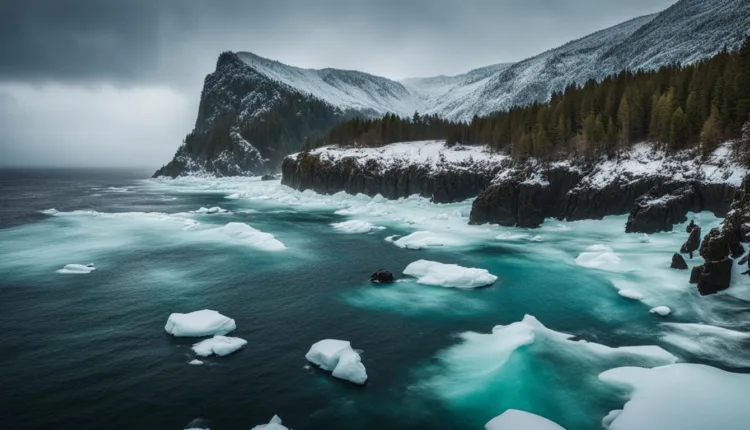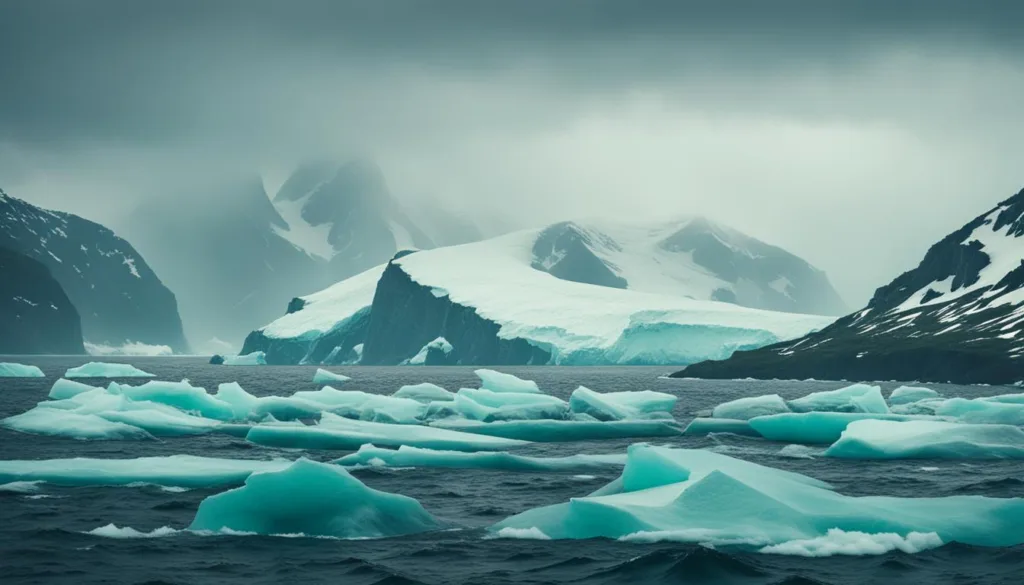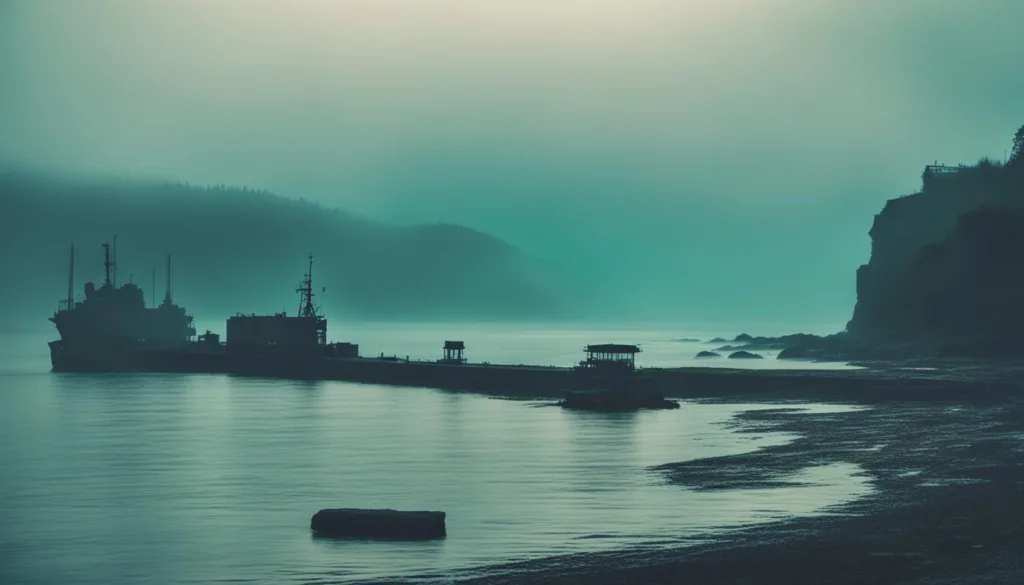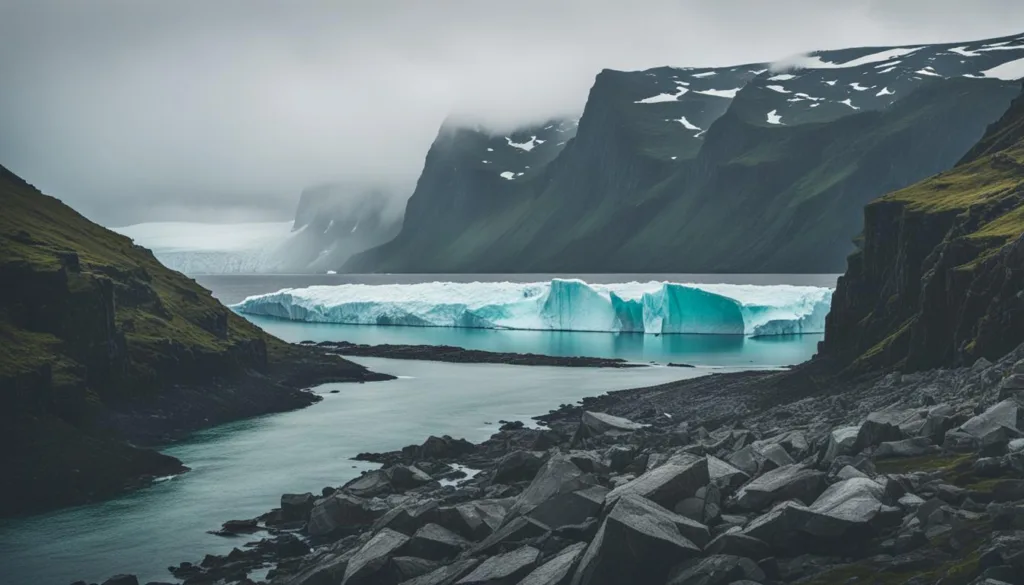Bouvet Island (Norway): Unveiling the Mysteries of the Antarctic Wilderness

Hello, fellow adventurers! Today, I want to take you on a journey to Bouvet Island, a captivating and remote destination nestled in the South Atlantic Ocean. This Norwegian territory, also known as Bouvetøya, is an uninhabited island shrouded in mystery and surrounded by the subantarctic volcanic landscape. Join me as we delve into the secrets of this wildlife sanctuary and explore the scientific research conducted in this truly unique location.
Key Takeaways:
- Bouvet Island is a remote and uninhabited Norwegian territory in the South Atlantic Ocean.
- It is known for its subantarctic volcanic landscape and serves as a wildlife sanctuary.
- The island has been a site for scientific research due to its unique geography.
- Bouvet Island is a challenging destination to explore due to its remote location and harsh conditions.
- Despite its isolation, adventure companies offer trips to experience the beauty of this Antarctic gem.
The Mystery of Bouvet Island
Bouvet Island, located in the South Atlantic Ocean, is a place shrouded in mystery and isolation. It is considered one of the most forbidding and remote places on Earth, with its unforgiving climate and challenging geographical features. The island was first discovered by Jean-Baptiste Bouvet de Lozier in 1739 but was lost for nearly 69 years due to inaccurate navigation. Despite its discovery, Bouvet Island remained elusive to explorers like Captain Cook for many years. It wasn’t until 1808 that the true location of the island was confirmed.
With its remote location and harsh conditions, Bouvet Island poses significant challenges for those who dare to explore it. The isolated nature of the island, coupled with its unforgiving climate and difficult terrain, makes it a captivating destination for adventurers seeking to test their limits. Its mysterious past, including its lost status and inaccurate mapping, only adds to the intrigue of this enigmatic island.
The discovery and subsequent exploration of Bouvet Island are testaments to the determination and resilience of explorers throughout history. Overcoming the navigational challenges and enduring the forbidding conditions of the island required immense courage and skill. Today, Bouvet Island remains an enigmatic and captivating destination, offering a glimpse into the untamed beauty and secrets of the Antarctic wilderness.
“Bouvet Island, with its isolated and forbidding nature, continues to captivate the imagination of explorers and scientists alike. Its mysterious history and challenging geography make it a unique and alluring destination for those seeking adventure and discovery.” – Olivia Grace, Travel Advisor
The Mystery Unveiled:
| Mystery | Explanation |
|---|---|
| Lost Island | Inaccurate navigation and mapping led to Bouvet Island being lost for nearly 69 years after its initial discovery. |
| Challenging Geography | Bouvet Island’s remote location, unforgiving climate, and difficult terrain make it one of the most forbidding places on Earth. |
| Isolation | The island’s isolated nature contributes to its mystery and allure, as it remains largely untouched by human presence. |
The Geography of Bouvet Island

Bouvet Island, located in the southern ocean, is characterized by its volcanic basalt terrain and extensive glaciers. The island’s rocky landscape is dominated by glaciers, with the central plateau rising to approximately 2,500 feet above sea level. However, its stunning beauty comes with a price, as the coastline is lined with towering ice cliffs that make it virtually unscalable and create a treacherous barrier for any approaching boats. As a result, Bouvet Island has very few accessible landing spots, further contributing to its isolation and inaccessibility.
The unique geology and harsh conditions of Bouvet Island have posed significant challenges for explorers and researchers alike. The rugged terrain, coupled with the island’s extreme weather patterns, make it a formidable location for scientific study and exploration. Its remote location and vast expanses of untouched wilderness add to the intrigue and mystique of this subantarctic volcanic island.
Exploring the Uncharted
The uncharted territories of Bouvet Island offer a tantalizing opportunity for further exploration and discovery. Despite the challenging geography and isolation, scientists and adventurers are drawn to the island’s pristine and untouched natural environment. It is here, in this remote and desolate landscape, that we have the opportunity to delve deeper into the mysteries of our planet, uncovering valuable insights into the Earth’s geological processes and the effects of climate change.
Table: Volcanic Basalt and Glaciers on Bouvet Island
| Characteristics | Details |
|---|---|
| Volcanic Basalt Terrain | Bouvet Island is characterized by its volcanic basalt terrain, resulting from its origins as a subantarctic volcanic island. |
| Extensive Glaciers | The majority of the island is covered by glaciers, with the central plateau rising to approximately 2,500 feet above sea level. |
| Towering Ice Cliffs | The coastline is dominated by towering ice cliffs, making it virtually unscalable and creating a treacherous barrier for approaching boats. |
| Limited Landing Spots | Bouvet Island has very few accessible landing spots due to its rugged geography, further contributing to its isolation and inaccessibility. |
As we continue to uncover the secrets of Bouvet Island, its unique geography and untouched wilderness provide a captivating backdrop for scientific research and exploration. This subantarctic volcanic island remains a testament to the raw power and beauty of nature, reminding us of the extraordinary wonders that exist in the most remote corners of our planet.
The Flora and Fauna of Bouvet Island
Bouvet Island, as a wildlife sanctuary, is home to a diverse range of animal species, both in the surrounding waters and on the island itself. Penguins, seals, orcas, and humpback whales are among the many marine creatures that inhabit the South Atlantic Ocean surrounding Bouvet Island. These majestic creatures can often be spotted swimming, hunting, and breaching in the frigid waters, offering a captivating spectacle for visitors.
On the island itself, various bird species have found their sanctuary, taking advantage of the remote and untouched environment. Snow petrels, black-browed albatrosses, and Antarctic prions are some of the bird species that call Bouvet Island their home. These resilient birds navigate the harsh conditions and rugged terrain, displaying their adaptability and survival skills.
“The presence of diverse wildlife adds to the natural beauty and ecological significance of Bouvet Island.”
– Olivia Grace
Exploring the flora of Bouvet Island reveals a more limited range of plant life due to its harsh climate. Mosses, lichens, and grasses cling to the rocky terrain, showcasing the tenacity of life even in the most challenging conditions. These small pockets of greenery provide a stark contrast against the barren landscape, highlighting the resilience and adaptability of plant life on Bouvet Island.
The flora and fauna of Bouvet Island are a reminder of the delicate balance of ecosystems and the importance of preserving and protecting these remote and biodiverse environments. Visiting Bouvet Island offers a rare opportunity to witness the beauty and diversity of nature in its purest form.
The Flora and Fauna of Bouvet Island – A Snapshot
| Flora | Fauna |
|---|---|
| Mosses | Penguins |
| Lichens | Seals |
| Grasses | Orcas |
| Humpback Whales | |
| Bird Species (Snow Petrels, Black-Browed Albatrosses, Antarctic Prions) |
As shown in the table above, the flora of Bouvet Island consists of mosses, lichens, and grasses, which have adapted to survive in the harsh climate. The fauna, on the other hand, includes penguins, seals, orcas, humpback whales, and various bird species. The combination of these unique plant and animal species contributes to the ecological significance and natural beauty of Bouvet Island.
Witnessing the thriving wildlife on Bouvet Island offers a humbling experience, reminding us of the intricate interconnectedness of different ecosystems and the importance of conservation efforts. It is a testament to the resilience of nature and the incredible adaptations made by flora and fauna to survive in extreme conditions.
Scientific Research on Bouvet Island
Bouvet Island (Norway) has been a hub for scientific research, particularly in the study of climate change and its impact on remote regions. The island’s unique geographic attributes and isolated location provide valuable opportunities for scientists to gather data and deepen our understanding of global climate patterns.
One area of focus for researchers on Bouvet Island is the analysis of ice layers. The island’s extensive glaciers serve as a record of past climate conditions, allowing scientists to study changes in temperature and atmospheric composition over time. By examining these ice layers, researchers can gain insights into the historical patterns of climate change and its implications for the future.
In addition to ice core analysis, scientists on Bouvet Island also collect weather and geographic data. The island’s remote location and harsh climate make it an ideal location to study extreme weather events and their connection to broader weather patterns in the Southern Ocean. By monitoring weather conditions and collecting data on temperature, precipitation, and wind patterns, researchers can contribute to our understanding of regional and global climate systems.
| Research Areas | Key Findings |
|---|---|
| Ice Core Analysis | Reveals historical climate patterns and temperature fluctuations |
| Weather Monitoring | Contributes to understanding extreme weather events and regional climate systems |
| Geographic Data Collection | Provides insights into the island’s unique geographic features and their influence on climate |
The scientific research conducted on Bouvet Island plays a crucial role in advancing our knowledge of climate change and its effects on remote regions. The data collected contributes to global climate models and helps inform policies and strategies for mitigating the impacts of climate change.
The History of Bouvet Island

Bouvet Island has a fascinating history that spans centuries. Its story begins with its discovery by Jean-Baptiste Bouvet de Lozier in 1739, but the island remained lost for many years, eluding even renowned explorer James Cook. Disputes over ownership followed, with both the British and Norwegians laying claim to the island at different times. Ultimately, Bouvet Island was annexed by Norway in 1930 and has been under Norwegian stewardship ever since.
The history of Bouvet Island is a testament to the challenges faced by early explorers and the allure of uncharted territories. The island’s remote location and unforgiving geography made it an enticing yet dangerous destination for those seeking new discoveries.
“Bouvet Island has a fascinating history that spans centuries.”
Despite its historical significance, Bouvet Island remains a largely unexplored and mysterious place. It serves as a reminder of the untamed beauty of our world and the enduring spirit of exploration.
The Annexation of Bouvet Island
One of the defining moments in the history of Bouvet Island was its annexation by Norway in 1930. The Norwegian government recognized the strategic importance of the island and asserted its sovereignty over the territory. This annexation solidified Bouvet Island as a Norwegian dependency and ensured its protection and preservation for future generations.
| Year | Event |
|---|---|
| 1739 | Discovery of Bouvet Island by Jean-Baptiste Bouvet de Lozier |
| 1808 | Confirmation of Bouvet Island’s true location |
| 1930 | Annexation of Bouvet Island by Norway |
The annexation of Bouvet Island marked a turning point in its history, ensuring its protection and preservation as a natural and scientific resource. Today, as a remote and uninhabited island, Bouvet Island continues to captivate adventurers and scientists alike with its intriguing past and untamed beauty.
The Abandoned Lifeboat Mystery
One of the most intriguing mysteries surrounding Bouvet Island is the discovery of an abandoned lifeboat in 1964. This enigmatic vessel was found in a small lagoon on the island, but its origin and the fate of its crew remain unknown. There were no markings or identifiable features on the boat, and a brief search yielded no evidence of human remains. The mysterious presence of the abandoned lifeboat adds an air of intrigue and curiosity to the already captivating history of Bouvet Island.
The unidentified origin of the lifeboat raises questions about what happened to its crew and why they abandoned their vessel in such a remote location. The lack of any tangible clues only deepens the mystery, leaving researchers and adventurers wondering about the untold story behind this enigmatic discovery. The abandoned lifeboat remains a silent witness to a lost chapter in Bouvet Island’s history, offering little insight into the events that transpired.
In an attempt to shed light on this mystery, various theories have been proposed, ranging from shipwreck survivors who managed to reach Bouvet Island to the possibility of an unknown expedition that met with an unfortunate fate. However, without concrete evidence or further discoveries, the true explanation remains elusive. The abandoned lifeboat remains a haunting reminder of the mysteries and unanswered questions that surround Bouvet Island, adding to its allure as an enigmatic and remote destination.
As we continue to explore the wonders of Bouvet Island, the abandoned lifeboat mystery serves as a reminder of the hidden secrets and untold stories that lie within this remote and uninhabited land. The unanswered questions surrounding the lifeboat are a testament to the enduring allure and captivating intrigue of Bouvet Island.
Bouvet Island in Popular Culture

Bouvet Island, with its remote and mysterious allure, has made its mark in popular culture, particularly in the movie Alien vs Predator. The island’s striking and otherworldly landscape served as a captivating filming location for this science fiction thriller. The inclusion of Bouvet Island in such a high-profile film has further piqued interest in this enigmatic destination.
Despite its challenging accessibility, adventure companies now offer trips to Bouvet Island, allowing intrepid travelers to embark on an extraordinary expedition to this Antarctic gem. These specialized tours provide a unique opportunity to witness the untouched beauty and pristine wilderness of Bouvet Island first-hand. It is a journey that promises unforgettable memories and a deep connection with nature.
As adventurers and thrill-seekers continue to seek out new and exciting destinations, Bouvet Island stands out as a truly extraordinary place to explore. Its presence in popular culture and the growing interest in visiting this remote outpost highlight the enduring fascination and allure of this exceptional destination.
“Bouvet Island has captured the imagination of filmmakers and adventurers alike. Its dramatic and untouched landscape has served as a backdrop for epic stories and a playground for those seeking the ultimate adventure.”
Experience the extraordinary world of Bouvet Island and discover for yourself why it has captured the attention of filmmakers, explorers, and adventurous souls from around the globe. Join me on this once-in-a-lifetime journey to explore the mysteries and wonders of Bouvet Island.
Quick Facts about Bouvet Island
| Location | South Atlantic Ocean |
|---|---|
| Classification | Norwegian territory |
| Popular Culture Appearance | Alien vs Predator (2004) |
| Accessibility | Specialized adventure tours |
| Highlights | Untouched wilderness, dramatic landscape |
The Erasure of Phantom Islands
Throughout the history of cartography, many phantom islands were mistakenly included on maps. These erroneous listings were often the result of geographical errors, optical illusions, or even deliberate myths. However, advancements in mapmaking and exploration eventually led to the eradication of these phantom islands as real explorations confirmed their nonexistence.
The inclusion of phantom islands on maps can be attributed to various factors. Geographical errors, such as miscalculations of latitude and longitude, contributed to the inaccurate depiction of landmasses. In some cases, optical illusions, such as mirages or floating icebergs, were mistakenly interpreted as solid land. Additionally, myths and legends perpetuated the belief in the existence of these phantom islands, further perpetuating their presence on maps.
As explorations and scientific advancements progressed, these inaccuracies were corrected. Real explorations confirmed the absence of these phantom islands, and cartographers started removing them from their maps. The eradication of phantom islands not only improved the accuracy of maps but also highlighted the importance of rigorous exploration and observation in cartography.
“The inclusion of phantom islands on maps is a fascinating chapter in the history of cartography. It showcases the challenges faced by early mapmakers and the evolution of geographical knowledge. Today, we have a much clearer understanding of the world’s landmasses, thanks to the painstaking efforts of explorers and cartographers.”
The Impact of Phantom Islands
The presence of phantom islands on maps had both practical and psychological implications. Navigational challenges arose when sailors relied on maps that contained nonexistent landmasses. Ships would set off on arduous and fruitless journeys in search of these phantom islands, wasting valuable time and resources.
Psychologically, the belief in phantom islands fostered a sense of wonder and curiosity about the unknown. These mythical lands sparked the imagination of explorers and adventurers, enticing them to embark on perilous voyages in search of the truth. The persistence of phantom islands in popular imagination reflects the enduring human fascination with uncharted territories.
While modern mapmaking techniques have largely eradicated phantom islands from official charts, their legacy endures as a reminder of the limits of geographical knowledge and the progress made in unraveling the mysteries of the world.
| Phantom Islands | Date | Reason for Erasure |
|---|---|---|
| Sandy Island | 2012 | Satellite imagery confirmed nonexistence |
| Hy-Brasil | 1877 | Exploration confirmed nonexistence |
| Frisland | 1660 | Exploration confirmed nonexistence |
The Legacy of Ghost Islands

Ghost islands, although they do not exist in reality, have had a significant historical significance and have played a role in exploration, dangers, and even diplomatic tensions. These imaginary lands have sparked the curiosity and adventurous spirit of explorers throughout history, leading them to embark on perilous journeys in search of these elusive destinations. Despite the inherent risks involved, explorers were driven by a desire to chart uncharted territories and expand their knowledge of the world.
The pursuit of ghost islands often exposed explorers to various dangers, including treacherous weather conditions, limited resources, and the risk of encountering hostile indigenous populations. These challenges tested the resilience and ingenuity of explorers, pushing the boundaries of human exploration. Additionally, the allure of these phantom lands occasionally led to diplomatic tensions as multiple nations laid claim to the same territories, fueling rivalries and disputes.
While the existence of ghost islands has been debunked, their legacy remains a testament to humanity’s unquenchable thirst for discovery and the limits of geographical knowledge. These imaginary lands have left a lasting impact on history, inspiring countless explorers and shaping the narratives of exploration. Although they may only exist in myth and legend, their influence on our understanding of the world is undeniable.
Table: Historical Significance of Ghost Islands
| Exploration | Dangers | Diplomatic Tensions |
|---|---|---|
| Explorers embarked on perilous journeys in search of ghost islands, expanding their knowledge of the world. | Explorers faced treacherous weather conditions, limited resources, and potential conflicts with indigenous populations. | Multiple nations laid claim to the same territories, leading to rivalries and disputes. |
| Ghost islands fueled the spirit of exploration, driving adventurers to chart uncharted territories. | Challenges tested explorers’ resilience and ingenuity, pushing the boundaries of human exploration. | Diplomatic tensions arose as nations vied for the control of these phantom lands. |
The Persistence of Phantom Geography
Phantom geography, with its roots in mythology and unconfirmed sightings, has left a lasting imprint on the world of mapmaking. Throughout history, mapmakers have grappled with the challenge of distinguishing fact from fiction, resulting in the inclusion of mythical lands and phantom islands on maps. These inaccuracies stemmed from various sources, such as old seafaring tales, optical illusions, and deliberate misinformation.
The persistence of phantom geography serves as a reminder of the limitations of early mapmaking techniques and the fallibility of geographical knowledge. Before the advent of modern exploration and accurate cartographic methods, maps were often influenced by myths and legends. These fantastical elements found their way onto maps, perpetuating the existence of ghostly lands that were, in reality, mere figments of imagination.
Uncovering the truth behind phantom geography required diligent exploration and scientific investigation. As technology advanced and explorers set out to conquer uncharted territories, the erroneous nature of many phantom islands was eventually revealed. These discoveries not only corrected maps but also expanded our understanding of the world, dispelling mythical notions and contributing to the evolution of accurate geographical knowledge.
The odyssey of mapmaking, riddled with phantom geography, reflects the tenacity and ingenuity of early explorers and cartographers. It highlights the perseverance of the human spirit in seeking to unravel the mysteries of the world. While modern mapmaking has largely eradicated phantom geography, the remnants of these myths and unconfirmed sightings continue to intrigue and fascinate, offering a glimpse into the rich history of cartography.
Modern Discoveries and Disappearances

Bouvet Island, with its remote location and rugged terrain, continues to offer surprises and mysteries that reflect the dynamic nature of our planet. Through volcanic activity, erosion, glacial melting, and rising sea levels, new discoveries and disappearances shape the ever-changing landscape of this enigmatic island.
Volcanic activity, one of the powerful forces at work on Bouvet Island, has the potential to create new landmasses. As molten lava erupts from the depths of the Earth, it can form new islands in the surrounding waters. These newly formed islands serve as a testament to the geologic processes that continue to shape our world.
On the other hand, erosion and glacial melting contribute to the disappearance of certain landmasses. The constant force of erosion wears away at the island’s coastline, gradually eroding its presence. Additionally, as glaciers melt due to rising temperatures, the land beneath them may become submerged, resulting in the loss of once-existent islands.
The rising sea levels caused by climate change further contribute to the disappearance of islands. As sea levels continue to rise, low-lying islands are at risk of being submerged entirely. This ongoing process emphasizes the fragile nature of these landforms and the importance of understanding and addressing climate change.
| Event | Effect |
|---|---|
| Volcanic activity | Creation of new islands |
| Erosion | Gradual landmass disappearance |
| Glacial melting | Submersion of previously existing islands |
| Rising sea levels | Inundation and loss of low-lying islands |
These modern discoveries and disappearances on Bouvet Island serve as a reminder of the ever-changing nature of our planet. They underscore the importance of environmental conservation and sustainability measures to ensure the preservation of these unique and fragile ecosystems.
Bouvet Island’s Evolving Status
Located in the remote reaches of the South Atlantic Ocean, Bouvet Island is an uninhabited landmass that has captivated explorers and scientists for centuries. Over time, this enigmatic island has undergone an evolving status, transitioning from an unexplored and mythologized territory to a recognized Norwegian possession. Today, Bouvet Island has gained attention as a destination for Antarctic cruises, allowing travelers to witness its pristine beauty and unique wilderness.
The remote location of Bouvet Island adds to its allure, as it is one of the most isolated places on Earth. Its uninhabited nature presents a rare opportunity to experience untouched landscapes and observe the natural world in its purest form. Despite the challenges posed by its geographic location, the increasing interest in Antarctic cruises has made it more accessible for adventurers seeking to explore this captivating destination.
“Bouvet Island offers a truly once-in-a-lifetime experience for those who dare to venture to its remote shores. The untouched landscapes and abundant wildlife create a sense of awe and wonder that cannot be replicated,” says Olivia Grace, Travel Advisor.
As a recognized Norwegian territory, Bouvet Island holds a significant place in the history of exploration and scientific research. Its evolving status reflects the achievements of past explorers and the ongoing efforts of scientists to unravel the mysteries of this unique landmass. While its remote location and uninhabited nature continue to pose challenges, Bouvet Island’s evolving status ensures its preservation as a testament to the beauty and resilience of Earth’s most remote places.
| Key Information | Details |
|---|---|
| Location | South Atlantic Ocean |
| Status | Norwegian territory |
| Accessibility | Through Antarctic cruises |
| Wildlife | Penguins, seals, orcas, humpback whales, various bird species |
| Scientific Research | Study of climate change, geographical data collection |
Conclusion
Bouvet Island (Norway) is a captivating destination that continues to intrigue adventurers and scientists alike. With its aura of mystery, fascinating history, and scientific research opportunities, this remote island offers a unique experience for those seeking to explore the world’s most challenging and enigmatic destinations.
As a recognized Norwegian territory, Bouvet Island serves as a wildlife sanctuary, providing a habitat for various species including penguins, seals, orcas, and humpback whales. Its status as a wildlife sanctuary adds to its allure and highlights its ecological significance in the South Atlantic Ocean.
Despite its beauty, Bouvet Island presents significant geographical challenges. Its volcanic basalt terrain, glaciers, and unscalable ice cliffs make it a difficult destination to access. However, adventurous travelers can now embark on Antarctic cruises to witness the island’s pristine wilderness firsthand.
From its mysterious past to its current status as a scientific research hub and wildlife sanctuary, Bouvet Island offers a remarkable blend of history, natural beauty, and geographical challenges. As one of the most remote destinations on Earth, it continues to captivate those who dare to venture into its enigmatic embrace.
FAQ
Is Bouvet Island inhabited?
No, Bouvet Island is uninhabited.
What is the geographical location of Bouvet Island?
Bouvet Island is located in the South Atlantic Ocean.
Who discovered Bouvet Island?
Bouvet Island was discovered by Jean-Baptiste Bouvet de Lozier.
What is the status of Bouvet Island?
Bouvet Island is a Norwegian territory.
Are there any landing spots on Bouvet Island?
Bouvet Island has very few landing spots due to its rugged coastline.
What wildlife can be found on Bouvet Island?
Bouvet Island is home to penguins, seals, orcas, humpback whales, and various bird species.
Has Bouvet Island been a site for scientific research?
Yes, Bouvet Island has been used for scientific research, particularly in the study of climate change.
How did Bouvet Island become Norwegian territory?
Bouvet Island was annexed by Norway in 1930.
What is the mystery of the abandoned lifeboat on Bouvet Island?
The origin and fate of the abandoned lifeboat found on Bouvet Island in 1964 remain unknown.
Can travelers visit Bouvet Island?
Adventure companies offer trips to Bouvet Island, allowing travelers to experience its unique beauty and wilderness.
What are phantom islands?
Phantom islands are landmasses that were mistakenly included on maps but do not actually exist.
What impact did ghost islands have on history?
Ghost islands sparked perilous journeys, dangers, and even diplomatic tensions in search of these imaginary lands.
How did phantom geography influence mapmaking?
Phantom geography, including ghost islands, resulted in distorted maps that were gradually corrected as mapmaking became more accurate.
Are there any modern examples of new discoveries and disappearances of islands?
Yes, volcanic activity, erosion, glacial melting, and rising sea levels continue to create new discoveries and disappearances of islands.
What is the evolving status of Bouvet Island?
Bouvet Island has gained attention as a destination for Antarctic cruises, despite its remote and uninhabited nature.


